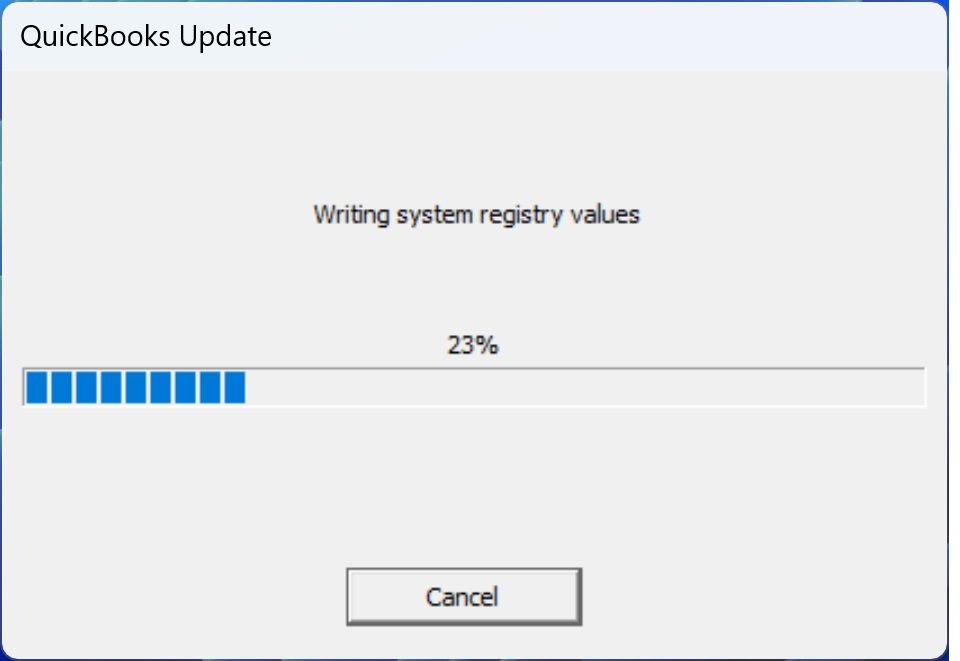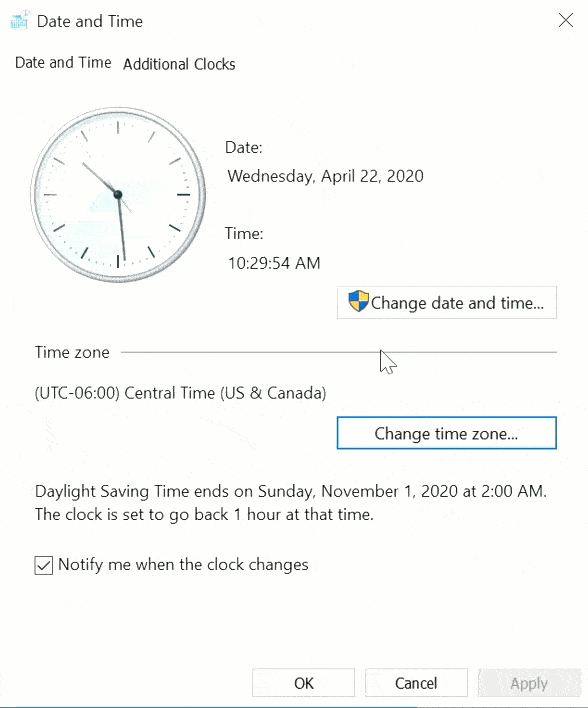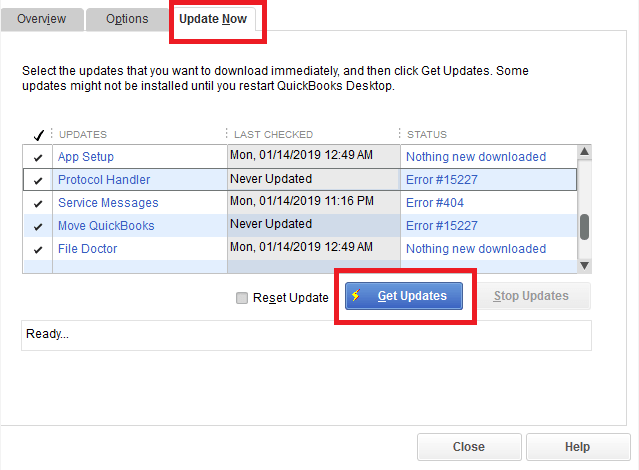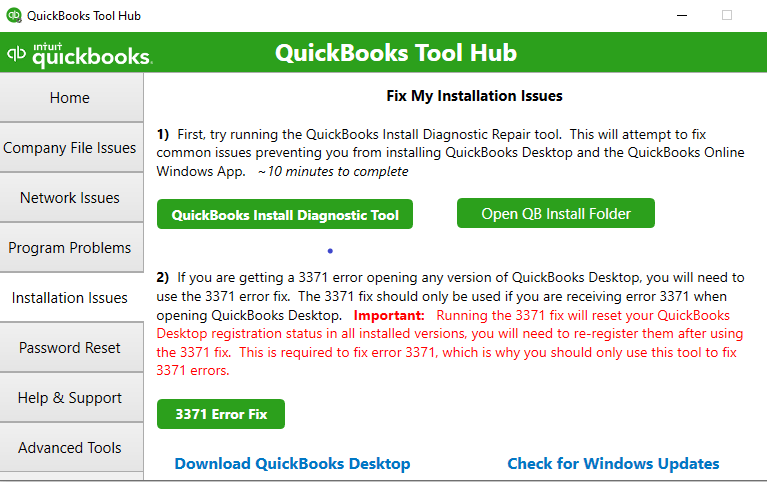Last Updated on July 28, 2025
Are you just tired of this frequent QuickBooks update stuck issue? This is a common but challenging issue encountered by users worldwide. With every update, QuickBooks seems to evolve and add more features to the program. Intuit also recommends that its users download the updates right away to avoid missing out on the updated features. A QuickBooks update stuck can be because of any QuickBooks desktop update error, which includes error codes 12045, 12157, 12037, 12038, and some 15xxx error series codes as well. Such errors prevent you from updating QuickBooks to the latest release and cause the ‘QuickBooks desktop update stuck error.
Are you unable to fix the QuickBooks Desktop update error? Speak to our dedicated Accounting Helpline experts by dialling our toll-free number 1.855.738.2784. They are all ears to understand your concerns and help you fix the software update issues instantly.
Meaning of QuickBooks Update Stuck at Writing Registry Values
The most common reason for QuickBooks update to get stuck is an issue with the system registry. Anytime QuickBooks cannot write to the system registry, it might encounter an error and fail during the update. It is where the system registry contains all the Windows and the applications installed on your system’s settings and information.

Generally, the error message that QuickBooks users face in such a situation is connected to system registry issues or extremely long periods of time for the updating process. According to QuickBooks Support, such a case where the application stopped writing to the system registry generally results from one of the following causes:
- The presence of corruption in the QuickBooks files will cause an error in the update process with regard to registry writing.
- Some security programs, such as firewalls or antivirus software, could block QuickBooks‘ access to the registry or prevent updates from being completed.
- You might not be able to install the update if you happen to be running an outdated version of QuickBooks, as it does not support your current operating system.
- Errors or corruption in the Windows system registry prevent a change required by QuickBooks from being made; the update will not be complete.
These were the causes of the QuickBooks Stuck at updating system registry issue. There can also be some QuickBooks update errors that can cause the issue of ‘QuickBooks update stuck at writing system registry values.’ Let’s have a look at the QuickBooks stuck on updating registry issue.
What Triggers QuickBooks Desktop Stuck Errors?
While updating QuickBooks, there are many things that could possibly go wrong and cause QuickBooks desktop errors. The general causes of QBDT update errors are:
- The PC’s time and date settings are incorrect.
- Update issues may arise from your unstable internet connection.
- Firewall ports and personal applications might cause interruptions during updates.
- If QuickBooks Desktop can’t verify the digital signature of your file, you’ll face problems with the QB Desktop update.
- Insufficient admin permissions on QB or Windows can trigger problems with QB updates.
- There may be compatibility issues because your system doesn’t meet the minimum requirements.
- If you have different versions of QuickBooks Desktop on your system, you will receive problems related to the QuickBooks update taking too long.
- Users may have a damaged file, requesting that they update it.
- The file may be read incorrectly on a Windows PC.
- Hard disk corruption or damage.
- Missing or damaged QBWUSER.INI file.
- An extended company name can cause a reboot problem while updating.
- Incorrect installation of QuickBooks Desktop.
- Outdated and old operating system.
- The configuration files might get bloated over time.
These are some of the common scenarios where you can expect QuickBooks update stuck errors. You can minimize the chances of such errors by keeping the above-mentioned points in mind.
What to do if QuickBooks Update Stuck in the Middle?
If your QuickBooks update gets stuck at 100%, 30%, 24%, 26%, 28%, or 34%, there might be a reason for the issue – it could be due to an internet connection problem, corrupted files, or a system conflict. Do the following:
- If there’s a QuickBooks update stuck at 100 writing system registry values, restart your computer and see if your internet connection has stabilized. Try reinstalling QuickBooks.
- If it is stuck at 30%, close all other applications, disable antivirus and firewall, and see if your internet has stabilized.
- If you are stuck in the reboot loop, restart in Safe Mode using the QuickBooks Clean Install Tool.
- If the results are 24%, 26%, or 28%, check that your internet speed is good, disable background programs, and run the File Doctor.
- On 34%, repair files with the File Doctor or reinstall QuickBooks.
- If there’s a QuickBooks update stuck on patching files, it means there is some issue in downloading the update or going ahead with it.
- If there’s a QuickBooks update stuck on writing registry values, this might be because of a firewall or antivirus security issues in QuickBooks.
Make sure you reach a stage where your system can store enough space and use the updated version of QuickBooks. Sometimes, it might feel that the QuickBooks update is taking too long to process. All you need to do is wait for some time and then proceed to the solutions.
Solutions to Fix QuickBooks Update Stuck Issue in Simple Steps
Now, the damage has been caused, and you have to deal with the QuickBooks update error. But don’t worry, users! We have got you covered. Here are some of the solutions that will help you fix QuickBook update stuck errors in quick and easy steps:
- Reconfiguring Date and Time Settings
- Verifying the Internet Connection Settings
- Updating QuickBooks Version Manually
- Installing the Digital Signature Certificates
- Downloading the Updates in Safe Mode
- Renaming the QuickBooks Components Folder
- Launching QuickBooks Install Diagnostic Tool
- Verifying Internet Security and Firewall Settings
- Running the Reboot.bat File
- Using Windows as an Administrator
These are the solutions that you can implement to resolve the QuickBooks Update Stuck issue on your desktop. Let’s have a look at each one of them in detail.
Solution 1: Reconfiguring Date and Time Settings
While downloading the update, if the digital signature certificate of Intuit shows validity dates that do not match your system’s date and time, the browser fails to recognize the website as secure, and the update fails to download. You can try to correct the date and time settings by following the steps mentioned below.
- Right-click the system clock on the desktop and tap Adjust Date/Time.

- Click on Change date and time and set the current date and time.
- Select OK twice.
- Close and then access QuickBooks Desktop again.
- Re-run the update for QuickBooks Desktop.
These are the steps to fix date and time issues on your computer. Now, if it does not resolve the QuickBooks update stuck error, you can proceed to the next solution.
Solution 2: Verifying the Internet Connection Settings
If your internet connection is down, try to check your bank’s website through a web browser. If you can’t visit the website, contact your internet service provider. However, if you can surf the internet on a browser, follow the steps below.
- Visit the Help menu in QuickBooks.
- Choose Internet Connection Setup and click on Use my computer’s Internet connection settings to establish a connection when this application accesses the Internet.
- Click on Next and go to Advanced Connection Settings.
- Visit the Advanced tab and choose Restore Advanced Settings.
- At last, click on OK and Done.
- Try to update QuickBooks again.
Verifying the internet connection settings is an important step in resolving the QB desktop update errors. Now, proceed to the next solution.
Solution 3: Updating QuickBooks Version Manually
If the user has installed and is currently running two different versions of QuickBooks Desktop on the same computer, the automatic update download will malfunction. In this case, you must download the updates manually for each QuickBooks version, one at a time, as follows:
- Exit from QuickBooks after closing down the company files and go to the desktop.
- Right-click on one of the QB icons and choose Run as administrator.
- Select the Help menu and click on Update QuickBooks Desktop.
- Under the Options tab, click on Mark All and choose Save.
- Go to the Update Now tab and put a tick mark on the Reset Update checkbox by clicking on it.
- Select Get Updates, and once the update finishes, close QuickBooks.

- Reopen QuickBooks and click Yes to install the updates.
- Repeat the same steps for the other QuickBooks version as well.
After proceeding to update the centre, you’ll be shown the “Hold tight, we’re updating your QuickBooks” text. This means that the QuickBooks software is currently being updated on your system. An updated application/software has a minimum chance of crashing or freezing.
Solution 4: Installing the Digital Signature Certificates
Suppose the existing digital signature certificate goes missing or gets deleted accidentally by some program. In that case, the Intuit servers cannot allocate the user’s software credentials, and the QuickBooks Desktop update fails even before the download starts. Follow the steps below to reinstall the digital signature certificate for QuickBooks.
- Exit from QuickBooks and press the Windows Key + E to open the File Explorer.
- Go to This Computer or My Computer and double-click on C: Drive.
- Under the Program Files folder, open the Intuit.
- Visit the QuickBooks folder and right-click on the exe file.
- Choose Properties and click on the Digital Signature tab.
- Verify that Intuit is checked in the signature list and go to Details.
- Click on View Certificate, and under the Certificate Window, choose Install Certificate.
- Keep selecting Next until the Finish button appears.
Finally, you need to reboot the system and open QuickBooks to download the updates again. If this method does not work out, you can try the next method.
Solution 5: Downloading the Updates in Safe Mode
Safe mode prevents any program from running automatically unless started by the user. If some other program is interfering with the QuickBooks update download, the user can try to download the QB updates in safe mode.
- Exit from QuickBooks and restart your computer system while holding the Shift key.
- The computer will start to choose an Option.
- Click on Troubleshoot and select Advanced options.
- Choose Startup Settings and click on Restart.
- Once it restarts, press the F4 key to start the computer in Safe Mode.
- Download the QuickBooks updates.
- Once the updates are downloaded, press the Windows Key + R to open the Run
- Type MSConfig in the search box and press Enter
- Under the Boot tab, click on Boot options and uncheck the Safe Boot 34%, repair files with the File Doctor, or try reinstalling QuickBooks.
Now, you need to restart the PC to open it in Normal Mode and install the updates by opening QuickBooks Desktop. If this does not work out, you can try the next solution for resolution.
Solution 6: Renaming the QuickBooks Component Folder
It might be possible that one of the previously downloaded updates is corrupted and is now causing issues in downloading the new updates. The only fix is to rename the folder by following the given steps.
- Exit from QuickBooks and go to the C:\ Program Data\ Intuit\ QuickBooks 20[YY]\ Components.
- 64-bit users, go to the C:\ Program Files (x86)\ Intuit\ QuickBooks 20[YY]\ Components.
- Right-click on the Components folder and select Rename.
- Add WBG at the end of its name and press the Enter key to save the action.
As soon as you open QuickBooks and access the company file, the program will create a fresh folder automatically.
Solution 7: Launching QuickBooks Install Diagnostic Tool
Usually, there might be problems such as improper installation, corrupted or broken installation files, Windows registry, or Microsoft components that might yield different types of errors. QuickBooks Install Diagnostic Tool fixes these problems with the components and registry. It is located in QuickBooks Tool Hub.
- Close all windows for QuickBooks Desktop.
- Open QuickBooks Tool Hub by double-clicking its application icon from your Desktop or Start menu.
- Now select the Installation Issues tab.
- Click on QuickBooks Install Diagnostic Tool.

QB Install Diagnostic Tool will begin to repair all the corrupt components and files that QuickBooks needs to work properly. When the tool is finished repairing, you must reboot the computer. Now, log in to your Windows as an admin, launch QuickBooks, and proceed with the update. But in case you observe the QuickBooks update stuck at 100 percent or some percent, let us proceed with the following solution.
Solution 8: Verifying Internet Security and Firewall Settings
Something else you should be aware of is that internet security settings or the firewall settings can stop QuickBooks updates. It could be why the QuickBooks update is stuck. So you should review Internet security settings as well as the settings of firewall software. Port 80 and port 443 should be opened, and the following programs should be able to use them:
- AutoBackupExe.exe
- Dbmlsync.exe
- DBManagerExe.exe
- FileMovementExe.exe
- IntuitSyncManager.exe
- QBCFMonitorService.exe
- QBGDSPlugin.exe
- QuickBooksMessaging.exe
- QBLaunch.exe
- QBServerUtilityMgr.exe
- QBDBMgr.exe
- QBDBMgrN.exe
- QBW32.exe
- FileManagement.exe
It is highly unlikely, but in exceptional situations, if other tasks are utilizing these ports, the QuickBooks Database server connects on a fallback port, that is, port 56719.
Solution 9: Running the Reboot.bat File
You may limit the source of unusual QuickBooks behavior and issues by using the reboot.bat file. It will allow the system to re-register the DLL and OCX QB files on Microsoft Windows. The steps to run the reboot.bat file are as follows:
- You should restart your system and subsequently right-click on the QuickBooks application.
- Navigate to the Properties tab and click on the option that reads Open File Location.
- In the top right corner’s search space, type reboot.bat.
When you look at the reboot.bat or reboot file, right-click and select the option to Run as Administrator. Finally, Windows will shut down after the reboot.bat file executes.
Solution 10: Using Windows as an Administrator
Ensure you have admin rights on the Windows operating system if you face QuickBooks Desktop update errors. Here’s how you create a Windows user account and switch to Administrator type in Windows 11/10:
- Open the Start menu, select Settings, and click on the Accounts option. Then, choose Family & Other Users (On some Windows versions, it may be labeled as Other Users).
- Look for the Add Other User option, check the box next to it, and click the Add Account option.
- Choose “I don’t have this person’s sign-in information” and click on “Add a user without a Microsoft account” on the subsequent page.
- Fill in a username, password, or password hint—or tap security questions—then click Next.
- Modify a local user account into an administrator account by navigating to the Start menu > Settings > Accounts.
- Under Family & Other Users, select the account owner’s name ( “Local Account” should be below the account name), and click on Change Account Type.
- Choose Administrator under the Account Type tab and click OK.
Now, you just need to sign in with the help of the newly created administrator account, and you are good to go.
QuickBooks Update Stuck – Memory Table for Reference
If you have read the complete blog, you can take a snapshot of the memory table for your reference. This will help you to prevent the error from happening again in the future. The table below shows the important information summed up in a table regarding the QuickBooks update stuck error.
| Issue | Quick Fix | Pro Tip 💡 |
| Stuck at Writing Registry | Disable firewall/antivirus → Run as Admin | Use QB Install Diagnostic Tool |
| Stuck at 100% or 30% | Restart PC → Reinstall QB | Check internet stability first! |
| Reboot Loop | Boot in Safe Mode → Clean Install | Back up company files first. |
| 24%, 26%, 28% Freeze | Run QuickBooks File Doctor | Close background apps. |
| Patching Files Hang | Manual update → Reset download | Verify disk space (>5GB free). |
| Digital Signature Errors | Reinstall certificates → Check date/time | Use Run as Admin. |
| Firewall Blocks Update | Whitelist QB ports (80, 443) | Temporarily disable security apps. |
| Corrupt Components | Rename Components folder → Restart | Let QB rebuild the folder. |
| Admin Permission Issues | Create a new Windows Admin account | Avoid guest/user accounts. |
| Multiple QB Versions Installed | Update each version manually | Uninstall unused versions. |
This table will help you memorise the important information, steps, and fixes.
Wait! The blog is not over yet. We still have something left for you.
QuickBooks Update Stuck Visual Flowchart (Bonus Section)
We have a bonus section for you – this visual flowchart for the QB stuck error. You can also have a look at this flowchart to have an idea of how to tackle this issue.
Now, it is time to go and implement the solutions provided in this blog post. You can also dial the toll-free number to look for professional help.
Wrapping It Up!
We hope our in-depth guide about the QuickBooks update stuck error resolves the problem easily. We have mentioned all the solutions in detail so you can apply the fixes easily without hassle. However, if you find yourself stuck or require expert supervision, we recommend contacting our dedicated team. They can not only provide practical solutions but also help resolve the error instantly.
Frequently Asked Questions (FAQs)
Why is my QuickBooks not updating?
There can be several reasons for QuickBooks failing to update. Generally, internet security or firewall settings can trouble QuickBooks updates. Outdated QuickBooks or Windows operating systems can also interfere with QuickBooks updates.
How do you update QuickBooks?
Once you log in to QuickBooks using your credentials, it will take you to the update now tab. Here, you need to select the most appropriate and current version of QuickBooks. Now, you just need to make your selection and click the Get Updates option.
When does the QuickBooks not updating error arise?
The QuickBooks won’t update, or the QuickBooks Update Is Stuck problem arises when you’re doing the following:
1. Undertaking manual updates
2. Automatic updates show no results
3. The update loading screen halts
How do I forcefully update QB Desktop?
The immediate update method includes the following:
1. Open QBDT.
2. Tap Help.
3. Select Update QB Desktop.
4. Pick the updates to download.
5. Hit Get Updates.
6. Close and reboot QuickBooks.
7. A wizard will emerge asking to install the app now or later.
Related Posts-
How to Unapply a Credit Memo in QuickBooks Desktop And Online
QuickBooks 941 Form: Filing, Due Dates, Errors, & Solutions
QuickBooks Check Alignment Problems – Troubleshoot Guide
QuickBooks Sales Tax Center Not Working? Know How to Fix in Simple and Quick Steps
Resolving QuickBooks Payroll Not Deducting Taxes Issue With Causes & Solutions to Fix
Fixing the ‘QuickBooks Requires that You Reboot Loop’ Issue in Simple Methods

Edward Martin is a Technical Content Writer for our leading Accounting firm. He has over 10 years of experience in QuickBooks and Xero. He has also worked with Sage, FreshBooks, and many other software platforms. Edward’s passion for clarity, accuracy, and innovation is evident in his writing. He is well versed in how to simplify complex technical concepts and turn them into easy-to-understand content for our readers.




